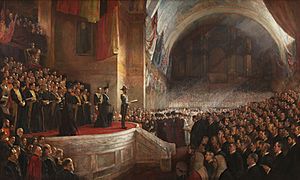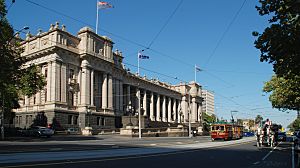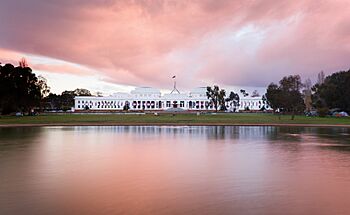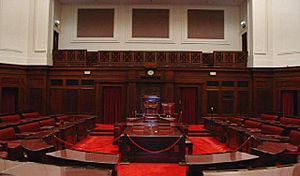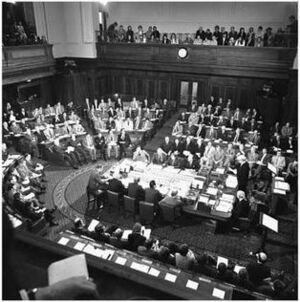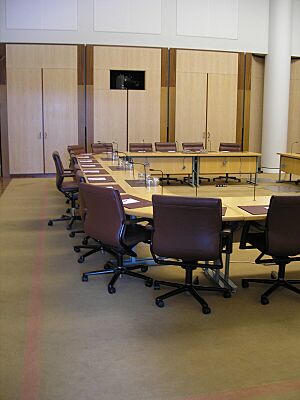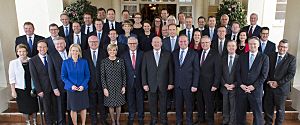Parliament of Australia facts for kids
Quick facts for kids Parliament of the Commonwealth |
|
|---|---|
| 47th Parliament of Australia | |
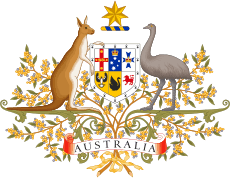
|
|
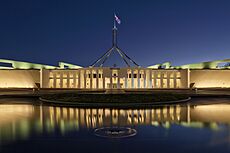
|
|
| Type | |
| Type | |
| Houses | Senate House of Representatives |
| History | |
| Founded |
|
| Leadership | |
|
Charles III
Since 8 September 2022 |
|
|
Sam Mostyn
Since 1 July 2024 |
|
|
Sue Lines, Labor
Since 26 July 2022 |
|
|
Milton Dick, Labor
Since 26 July 2022 |
|
| Structure | |
| Seats | 227 (151 MPs, 76 Senators) |
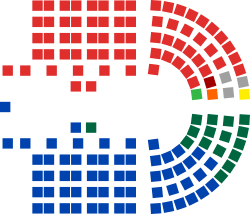 |
|
|
House of Representatives political groups
|
Government (77) Labor (77) |
 |
|
|
Senate political groups
|
Effective 1 July 2022 Government (26) |
|
Length of term
|
House: 3 years (maximum) Senate: 6 years (fixed except under double dissolution) |
| Elections | |
| Preferential voting with full preferences | |
| Single transferable vote (proportional representation) | |
|
House of Representatives last election
|
21 May 2022 |
|
Senate last election
|
21 May 2022 (half) |
|
House of Representatives next election
|
2025 |
|
Senate next election
|
2025 (half) |
| Redistricting | Redistributions at least every seven years in each state and territory by the Redistribution Committee |
| Meeting place | |
 |
|
| House of Representatives Chamber | |
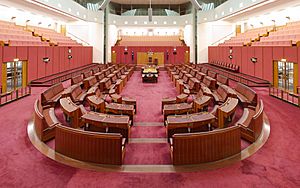 |
|
| Senate Chamber | |
The Parliament of Australia is Australia's main law-making body. It is also known as the Federal Parliament. It has three parts: Australia's King (represented by the Governor-General), the Senate (the upper house), and the House of Representatives (the lower house).
The Parliament uses ideas from two systems. One is the Westminster system (from the UK), where the party with the most votes in the lower house forms the government. The other is like the United States Congress, where each state has an equal say in the Senate. This helps make sure laws are carefully checked before they become official.
The upper house, called the Senate, has 76 members. Each of Australia's six states has twelve senators. The two self-governing territories (Northern Territory and Australian Capital Territory) each have two senators. Senators are chosen using a system called proportional representation. This means many different political parties can win seats. The party that forms the government usually does not have a majority in the Senate. This means they often need to work with other parties to pass new laws.
The lower house, called the House of Representatives, currently has 151 members. Each member is chosen by voters in a specific area, called an electorate. They are elected using a system called preferential voting. This system usually leads to two main political groups dominating the House. These are the Coalition (made up of the Liberal and National parties) and the Labor Party. The government must have the support of the House of Representatives to stay in power.
The House of Representatives can serve for up to three years, but elections can happen sooner. Senators from states serve fixed six-year terms, with half of them facing election every three years. Territory senators are elected every three years. Because of this, elections for both houses almost always happen at the same time. If the Senate keeps rejecting a law passed by the House, there's a special rule called a double dissolution. This allows both houses to be dissolved and new elections held.
The two houses meet in separate rooms inside Parliament House. This building is on Capital Hill in Canberra, Australia's capital city. Sometimes, they have special joint sittings where both houses meet together.
Contents
History of Australia's Parliament
Early Days in Melbourne (1901–1927)
Australia became a nation on 1 January 1901 when its six colonies joined together. The first federal election was held in March 1901. The very first Australian Parliament officially opened on 9 May 1901 in Melbourne. Prince George, who later became King George V, opened it.
The opening ceremony was held in the Royal Exhibition Building. It was the only place big enough for all 14,000 guests. After the opening, from 1901 to 1927, the Parliament met in Parliament House, Melbourne. This building was usually used by the Parliament of Victoria, which moved to the Royal Exhibition Building during this time.
Old Parliament House (1927–1988)
Australia's Constitution said a new national capital would be built. This was a compromise because Sydney and Melbourne both wanted to be the capital. The location for the new capital, Canberra, was chosen in 1908.
A competition was held to design Parliament House, but it was cancelled twice because of World War I. So, John Smith Murdoch, the government's chief architect, designed the building. He didn't think it was a good use of money at the time, but he designed it anyway.
Construction of what is now called Old Parliament House began in 1923 and finished in 1927. It cost about £600,000, which was more than three times the first guess. It was meant to be used for only 50 years, but it was used for over 60 years!
The Duke and Duchess of York (who later became King George VI and Queen Elizabeth) opened the building on 9 May 1927. The opening was grand, even though Canberra was still quite small. The building was decorated with flags. Crowds filled temporary stands outside. An Aboriginal elder, Jimmy Clements, walked for about a week to be there. Dame Nellie Melba, a famous singer, sang "God Save the King". The Duke unlocked the doors with a golden key and unveiled a statue of his father, King George V. Then, he opened the first parliamentary session in the new Senate Chamber.
New Parliament House (1988–Present)
In 1978, the government decided to build a new Parliament House on Capital Hill. A design competition was held, and 329 designs from 29 countries were submitted.
The winning design came from an American architecture firm. The main architect, Romaldo Giurgola, designed most of the building to be hidden under Capital Hill. It has a huge spire on top with a large Australian flag. The outside of the new building was designed to look a little like the Old Parliament House, even though it's much bigger. It was also made to appear as if it sits above the Old Parliament House from a distance.
Building started in 1981. It was supposed to be ready by Australia Day, 26 January 1988, for Australia's 200th anniversary. It was expected to cost $220 million. But it wasn't finished on time or on budget. It ended up costing over $1.1 billion.
New Parliament House was finally opened by Queen Elizabeth II on 9 May 1988. This date was special because it was also the anniversary of the opening of the first Federal Parliament in Melbourne (1901) and the Old Parliament House in Canberra (1927).
In March 2020, the Parliament paused its meetings because of the COVID-19 pandemic in Australia. This was unusual, but committees continued their work using technology.
How Parliament is Made Up
The Australian Constitution sets up the Parliament. It says Parliament has three parts: the King of Australia, the Senate, and the House of Representatives.
The Monarch's Role
The King's duties in Australia are carried out by the Governor-General. The King appoints the Governor-General based on the advice of Australia's Prime Minister. Usually, the Governor-General acts on the advice of government ministers.
In Parliament, the King shares law-making powers with the Senate and House of Representatives. For a bill to become a law, the King's approval (called royal assent) is needed. This is usually given by the Governor-General. The Governor-General is expected to approve bills passed by both houses.
The Senate: Australia's Upper House
The Senate is the upper house of the Australian Parliament. It has 76 members. Like the United States Senate, it gives an equal number of senators to each state, no matter how many people live there.
The Constitution says Parliament can decide how many senators there are. But it must make sure the six original states have equal representation. Each original state must have at least six senators. Since 1973, senators have also been elected to represent the territories.
Currently, the two senators for the Northern Territory represent people there, plus those on Christmas Island and the Cocos (Keeling) Islands. The two senators for the Australian Capital Territory represent people there, plus those in the Jervis Bay Territory and Norfolk Island. State senators serve six-year terms, with half elected every three years. Territory senators are elected every three years.
The way senators are elected has changed over time. Since 1948, a system called single transferable vote proportional representation has been used. This system has helped smaller parties like the Australian Democrats and Australian Greens win seats. This means they can have a say in Parliament and often hold the balance of power.
The House of Representatives: Australia's Lower House
The House of Representatives is the lower house of the Australian Parliament. Its members are elected from areas called electorates, which have roughly the same number of people.
The party or group of parties that wins the most seats in this House forms the government. Their leader becomes the Prime Minister. If the government loses the support of the House, they are expected to call a new election or resign.
Parliament can decide how many members are in the House of Representatives. But the Constitution says there must be "nearly twice the number of Senators." So, the House currently has 151 members. Each state gets seats based on its population. However, each original state is guaranteed at least five seats, no matter its size.
The Constitution does not guarantee representation for the territories. The Northern Territory got a seat in 1922, and the Australian Capital Territory in 1948. These representatives had limited voting rights until 1968. The boundaries of electorates are redrawn when states or territories gain or lose seats, or if populations change a lot, or every seven years.
From 1901 to 1949, the House had 74 or 75 members. Between 1949 and 1984, it had between 121 and 127 members. In 1984, both the Senate and the House grew larger. Since then, the House has had between 148 and 151 members.
Since 1919, members of the House of Representatives have been elected using full preferential voting. This system helps the Coalition parties work together in elections.
Rules for Both Houses
You cannot be a member of both the Senate and the House of Representatives at the same time. However, some people have been members of both houses at different times in their careers.
To be elected to either house, you must be an Australian citizen. You also cannot be a citizen of a "foreign power." This means you can't be a citizen of another country.
Voting in federal elections became compulsory in 1924. This happened because voter turnout was very low in the 1922 election. A Senator suggested the change, and it was passed quickly. Since then, voter turnout has been very high, around 95%.
Since 1973, Australians can vote when they turn 18. Before that, the voting age was 21.
Since 2015, Australian Federal Police officers with weapons have been present in the Federal Parliament. This was the first time armed personnel were in an Australian parliament.
How Parliament Works
Each house chooses a leader. The Senate's leader is called the President. The House of Representatives' leader is called the Speaker. These leaders are usually from the government party. They are expected to be fair and make sure debates follow the rules.
The Constitution says how many members must be present for each house to meet. This is called a quorum. For the Senate, it's 19 members. For the House of Representatives, it's 31 members. If a quorum isn't present, the house can't officially meet. However, members often agree to keep going even if not enough are there for routine discussions. Sometimes, the Opposition might "call a quorum" to slow things down or make a point.
Both houses often decide on motions by a voice vote. The leader asks for "Ayes" and "Noes" and announces the result. If at least two members disagree, they can ask for a "division" or a recorded vote. Bells ring to call members to the chamber. Members who support the motion go to the right side, and those against go to the left. They are then counted.
In the Senate, the President can vote like other senators. If there's a tie, the motion fails because the President doesn't have an extra casting vote. In the House of Representatives, the Speaker usually doesn't vote. But if there's a tie, the Speaker has a casting vote to break it.
Most new laws (bills) start in the House of Representatives. They go through several steps before becoming law. The process happens in English.
- First reading: The bill is introduced.
- Second reading: Members vote on the general idea of the bill.
- Committee stage: Sometimes, a committee looks at the bill in detail and suggests changes.
- Consideration in detail: The House discusses each part of the bill and can make changes.
- Third reading: The House votes to pass or reject the final bill.
If the House passes the bill, it goes to the Senate. The Senate has a similar process. Once both houses pass the bill in the same form, it goes to the Governor-General for royal assent to become law.
What Parliament Does

The main job of Parliament is to make laws. Any member of Parliament can suggest a new law (a bill). However, bills about money (like taxes or spending) must start in the House of Representatives. Most bills are introduced by government ministers.
All bills must be passed by both the House and the Senate. Then, the Governor-General must approve them to become law. The Senate has almost the same power to make laws as the House. But it cannot start or change money bills; it can only pass or reject them.
The Commonwealth Parliament can only make laws about things listed in the Constitution. Things not listed are "residual powers" and are left to the states. Section 51 gives the Commonwealth power over areas like taxes, foreign affairs, defence, and marriage. States can also ask the Commonwealth to make laws about certain matters.
Parliament also does other important things. Members can discuss urgent issues or matters important to the public. This allows for debates on government policies. Senators and members can also raise issues important to their voters. They can even propose a vote of no confidence against the government or a minister.
Most sitting days include a question time. During this time, members can ask questions to the Prime Minister and other ministers without warning. Members can also present petitions from their voters. Both houses have many committees. These committees discuss bills, investigate public policy, gather information, and question government officials. There are also joint committees with members from both houses.
When Houses Disagree
If the two houses cannot agree on a law, the Constitution has a special rule called a double dissolution. This means both houses can be dissolved at the same time, and a new election is held for all seats in both houses.
Section 57 of the Constitution explains this. If the House passes a law, and the Senate rejects it or changes it in a way the House doesn't agree with, and this happens again after three months, the Governor-General can dissolve both houses.
In a double dissolution election, each state elects all 12 of its senators. This makes it easier for smaller parties to win seats. If the disagreement continues after this election, the Governor-General can call a joint sitting of both houses. All members from both houses meet together to vote on the bill. If the bill passes with a majority of all members, it becomes law. This has only happened once, after the 1974 election.
Parliamentary Committees
Besides the main meetings, both the Senate and the House of Representatives have many committees. These committees investigate issues and check on government activities. They allow members and senators to ask questions of witnesses, including ministers and public officials. They also look into policies and new laws.
After an investigation, the committee writes a report. This report is given to Parliament and includes what they found and any suggestions for the government.
Parliamentary committees have important powers. One key power is being able to ask people to come to hearings to give information and documents. If someone tries to stop a committee's work, they can be found in contempt of Parliament. This means they have disrespected Parliament. Examples include refusing to appear, refusing to answer questions, or lying to a committee.
Committee meetings are treated like Parliament meetings. What is said is recorded and protected by parliamentary privilege. This means committee members and witnesses are protected from legal action for what they say during a hearing.
Here are some types of committees:
- Standing committees: These are permanent committees. They check bills, look at the government's budget, and review annual reports from government departments.
- Select committees: These are temporary committees set up for a specific issue. They finish when they publish their final report.
- Domestic committees: These manage Parliament's own affairs, like how bills are dealt with or issues of parliamentary privilege.
- Legislative scrutiny committees: These check new laws and rules to see how they affect people's rights and government accountability.
- Joint committees: These include members from both the House of Representatives and the Senate. They can be permanent or temporary.
Parliament's Link to the Government
The Constitution says the Governor-General can appoint and remove ministers. Ministers are in charge of government departments. In practice, the Governor-General appoints ministers based on the traditions of the Westminster system.
The Governor-General appoints the leader of the party with the most seats in the House of Representatives as Prime Minister. Then, on the Prime Minister's advice, the Governor-General appoints other ministers. These ministers are chosen from the winning party or group of parties.
These ministers form a group called the Cabinet. Cabinet meetings are private and happen once a week. Important issues are discussed, and policies are decided there. The Constitution doesn't officially recognize the Cabinet, but it's where the real decisions are made.
A minister doesn't have to be a member of Parliament when first appointed. But they must become a member of either the Senate or the House within three months.
The Senate's Important Role
Unlike upper houses in some other countries, the Australian Senate is very powerful. It was not just meant to be a place to review laws. It was partly designed like the United States Senate, giving each state equal representation. This was to give smaller states a stronger voice in the federal government.
One of the Senate's jobs is to check on the government. For many years, the government party has rarely had a majority in the Senate. This means opposition and minor parties can use their numbers in the Senate to investigate what the government is doing.
The Constitution stops the Senate from starting or changing annual money bills (like the budget). But the Senate can delay or reject these bills. This means the Senate can effectively stop the government from getting the money it needs to operate. This is known as "blocking supply".
The ability to block supply led to the 1975 Australian constitutional crisis. The Opposition in the Senate delayed money bills, demanding an election. The Prime Minister, Gough Whitlam, refused to resign. The Governor-General, Sir John Kerr, then dismissed Whitlam's government and appointed Malcolm Fraser as caretaker Prime Minister. This action was very controversial, and people still debate whether the Senate should have this power.
Blocking supply alone cannot force a double dissolution. There must be other laws that the Senate repeatedly blocks for the government to use it as a reason for a double dissolution.
Parliamentary Departments
Four departments help the Australian Parliament do its work:
- Department of the Senate: Supports the Senate and its committees.
- Department of the House of Representatives: Helps the House of Representatives and its committees run smoothly.
- Department of Parliamentary Services (DPS): Provides various support services. This includes research, the Parliamentary Library of Australia, broadcasting Parliament on radio and TV, Hansard (official records of debates), computer services, and building maintenance and security.
- Parliamentary Budget Office (PBO): Helps make government spending and budget information clearer. It also provides cost estimates for politicians.
Parliamentary Privileges
Members of the Australian Parliament do not have legal immunity. They can be arrested and tried for crimes. However, they have parliamentary privilege. This means they cannot be sued for anything they say in Parliament about other members or people outside Parliament. This protection also applies to media reports of what is said in Parliament. Committee meetings are also covered by this privilege, including witnesses who give evidence.
Since 1987, the Parliamentary Privileges Act has explained what privilege means and how Parliament deals with any breaches.
There is a legal offense called contempt of Parliament. If someone speaks or acts in a way that disrespects Parliament or its members, they can be tried and, if found guilty, imprisoned. This power is now handled by the courts.
Broadcasting Parliament
Radio broadcasts of parliamentary meetings started on 10 July 1946. They are now broadcast on ABC News, a government-owned radio channel. It broadcasts 24 hours a day, showing other news when Parliament is not meeting.
The first time Parliament was shown on TV was during the historic 1974 Joint Sitting. Regular TV broadcasts of question time began in 1990 for the Senate and 1991 for the House of Representatives. House of Representatives question time is shown live. Senate question time is recorded and shown later that day. Other televised events include the Treasurer's Budget speech, the opening of Parliament by the Governor-General, and speeches by visiting world leaders.
In 2009, a pay TV company launched a channel called A-SPAN (now Sky News Extra). It broadcasts live meetings of both houses, committee meetings, and press conferences.
The official Parliament House website also provides free live streams of both chambers and committee hearings online.
See also
 In Spanish: Parlamento de Australia para niños
In Spanish: Parlamento de Australia para niños
- List of legislatures by country


